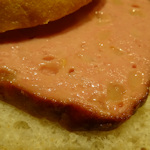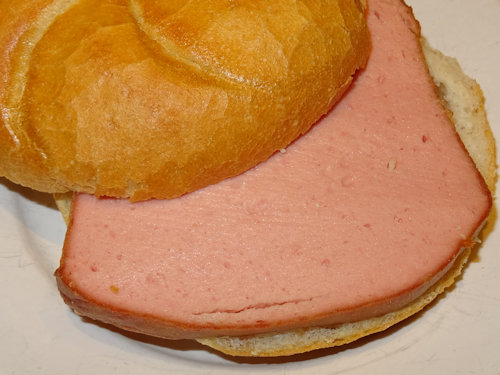
One of the best ways to ruin a fine weight-loss diet in Vienna is by eating a Leberkäsesemmel: a round white bread roll (Semmel) with a warm slice of, well, Leberkäse inside. But what is Leberkäse, exactly?
- Fat-rich meatloaf that comes in several variations
- Probably not a major component of a well-balanced diet
- …but (unfortunately) very tasty
- Book a concert & dinner* for Vienna
- See also:
Not what it sounds like

(A very basic no frills Leberkäsesemmel)
The delicatessen counter at most supermarkets will happily sell you a Leberkäsesemmel. You also find it in football club canteens, markets & festivals, some bars, and even at the many sausage stands around the city.
So let us reveal the mystery of the roll’s filling…
A quick look at your German-English dictionary tells you that Leber means liver and Käse means cheese. So what we have here is clearly “liver cheese”, a name lacking in both charm and, as it turns out, accuracy.
Neither liver nor cheese make an appearance in Austrian “liver cheese” (but see below). It might best be described as a kind of meatloaf.
The slice in your Leberkäsesemmel traditionally comes from a baked, crusty loaf, where some combination of finely-chopped pork, bacon and beef typically form the main ingredients.
Sometimes Leberkäse contains horse meat, lamb, or game as its main content, but is always labelled as such.
The result looks a little like a pinkish pate but is much firmer.
As you might imagine, Leberkäse is not exactly fat-free (you have been warned), but it is remarkably tasty (again, you have been warned). Common variants in Vienna are:
- Käseleberkäse – with added melted cheese, just in case you wanted even more fat
- Pikant Leberkäse – with red and green bits of spicy peppers mixed in (my favourite variety before I turned vegetarian)
- Chilileberkäse – spiced up with hot chilli
- Pferdeleberkäse – made with horsemeat
- Wildschweinleberkäse – made with wild boar (you often get this alternative sold at the Viennese Christmas markets, for example)

(Vienna even has a specialist snack bar selling Leberkäse for eating on site or to take away. Last I checked, Leberkas-Pepi has locations at the airport, Hauptbahnhof station, Donauzentrum shopping complex, and on Operngasse in the centre of town)
You increasingly find veganer Leberkäse (vegan) options, too, particularly at those seasonal markets. This plant-based version seems to get better with each passing year.
Although most Leberkäse is bought and consumed hot in a roll, perhaps with ketchup or mustard, you can buy the “delicacy” in supermarkets as thin cold slices to eat like ham or as uncooked part-loaves for home baking (to be eaten in the traditional roll or on its own).
Some bars and restaurants also serve Leberkäse as a dish, which often just means a more upmarket presentation of the bread and slices.
So is the name Leberkäse some kind of linguistic joke?
Not really.
The words Leber and Käse have nothing to do with the common meaning of each: they almost certainly stem from adaptations of traditional German words like Laib and Kas that reflect the shape and consistency of the baked loaf. But nobody knows for sure.
Laib still means loaf or cob today. A Brotlaib, for example, is a round or oval loaf of bread.
To really confuse matters you need to take a trip to Germany, where calling something liver cheese is a bit of a no-no unless it actually has liver in it.
So any Leberkäse sold in that country is expected to include liver…unless you’re in Bavaria. Outside Bavaria, liver-free Leberkäse is known as Original Bavarian Leberkäse. It’s all a bit confusing.
Perhaps you’re safer sticking to Schnitzel. Or Vienna.